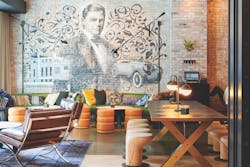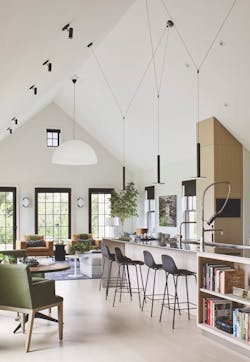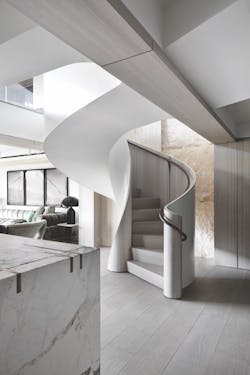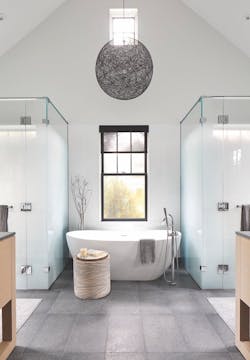Backstory: Growing Up
In 2006, Matt Berman and Andrew Kotchen, founding principals of Workshop APD, won the international design competition sponsored by Global Green USA and Brad Pitt to rethink New Orleans’ Lower Ninth Ward in the wake of Hurricane Katrina. The project included a model block with five single-family homes, a community center, and an apartment building—all of it to be built to a high standard of sustainability.
Heady stuff for two designers who at the time had been in business for just six years. “It was crazy that we won, and it really changed a lot for us,” Berman says. “It put us on the map, nationally. Our names and faces were in People magazine, which isn’t typically where architects show up. [Doing the project] opened our eyes to larger-scale development.”
Ideas to Practice
Berman and Kotchen met at Lehigh University in Pennsylvania where both were studying architecture. Their interest in clean, edited design drew them together. When they graduated in 1994, they went their separate ways—Kotchen to graduate school at the University of Michigan in Ann Arbor and Berman to graduate school at Columbia University in Manhattan.
In the living room of a private Nantucket residence, the layering of materials and textures speaks to Workshop APD's "crafted modern" aesthetic.
Photo: Read McKendree
Kotchen headed to Nantucket, Mass., in 1997, where he began working in home building. Berman took a different route, leaving graduate school after a year to work for ANY (Architecture New York), “an esoteric periodical; a think tank product started by [architect] Peter Eisenman,” Berman says. “It was heady and profound, an amazing experience for a 24-year-old kid. I got to meet architects like Zaha Hadid and Daniel Libeskind and learned how they thought about craft at a high level. But eventually, I realized I wanted to focus on making projects.”
Leveraging Talents
Berman met up again with Kotchen in 2000 and they founded Workshop APD. The firm started out small, with just Berman and Kotchen designing single-family homes. They brought in a third partner, licensed architect Thomas Zoli, in 2011.
The firm continued to do work in Nantucket, but today, with a staff of 50, including architects, interior designers, and product designers, Workshop APD designs single-family homes all over the country and even in the Bahamas. But its real success comes not just from having great designers; Berman and Kotchen have been able to leverage what they learned to create a vertically integrated, comprehensive design studio that focuses on four areas: single-family residential, multifamily residential, hospitality, and product design.
Photo: Read McKendree
In the beginning, Berman says, “We were young and hungry,” and in an effort to move from smaller residential work to larger, more lucrative residential and multifamily, “we’d [meet with prospective clients] and be honest, saying, ‘We’ve never done a multifamily project,’ for example.” Then the architects would do their presentation, in which they would convey their knowledge of the sequence of movement and understanding of the concepts of entry (lobby, corridor, elevator, and on into a unit or home), how they define transitional experiences and particular spaces, such as kitchens, and so on. “We were able to show how we think about these facets, as opposed to focusing on the project type. We knew what we were talking about and were honest about what we didn’t know,” Berman says.
The same method has worked for them each time they’ve engaged in something new, whether it’s a restaurant, large-scale development (such as the Brooklyn Navy Yard), a hospitality project, or product design. “At the end of the day, good design is about tackling a problem in an artful way,” Berman says.
In many cases, Workshop APD has the opportunity to use more than one “vertical” on a project. For example, on a project in New York City’s West Village that includes a nine-story tower and five townhouse units, the firm designed the buildings, all of the interiors, and created custom products, such as light fixtures, coffee tables, and consoles, for the models. Each vertical is its own profit center under one big umbrella, Berman says.
Modern Problems
While their design philosophy is decidedly modern, it’s more contemporary—what Berman calls “livable modern,” rather than minimal in the sense of being so streamlined that it’s stripped of expression. “We both were brought up being connected to materials, to nature, in families that actually used their homes and lived in them. We appreciate modern architecture and design but want it to be something comfortable and familiar,” he says.
Photo: Read McKendree
In their work, they show a love for craft and use natural materials—wood or stone, for example—that “have knots and veins. They’re not perfect. There’s beauty in imperfection that we love to explore,” Berman says. “We talk about accident, happenstance, and the unpredictable balanced with the curated, edited, and machined. That’s the world we like to work in.”
One challenge the team sometimes faces is finding contractors who can execute their designs to the firm’s specifications. For that reason, they try to work with the same contractors. “Modern work can be more difficult to produce than traditional buildings [where] you have more fudge factor; you can hide things behind molding, trim, and casings,” Berman says. “But when you specify a ¼-inch reveal to track around an entire room, you don’t have much leeway. If it’s not spot on, most eyes will pick it up.”
Growing Organically
There was no real plan involved in the way the company has developed. “If anything,” Berman says, “our plan was just to leverage what we were doing into the next thing, but we couldn’t have mapped out the next thing.”
Yet there are some calculations involved. Berman and Kotchen do plan ahead, but only six to 12 months. “That’s enough time to see a curve coming in and to strategize,” Berman says. “Trying to map out the next five years is too difficult. You just have to think in a way that you have enough information to inform the decisions you make.” He believes each step in their company’s growth occurred organically.
Now, after nearly 20 years, Berman says, they’re talking about chapter two. “We’ve built an incredibly strong foundation and built a brand that is recognized in the industry. The second phase is going to be growing beyond the founders. We have an unbelievably talented team.” They are just exploring the idea of succession planning.
Back when they had named the business Worskhop APD, Berman says he and Kotchen thought it obvious that APD stood for “architecture, planning, and design. But people still ask us about it all the time. When we were naming it, we thought Kotchen and Berman or Berman and Kotchen would sound like a law firm.”
Ultimately, though, having a business name that wasn’t eponymous has led them to “have an added layer of credibility and be able to really focus on building a brand.” Now that brand is recognized in the industry. “When we talk to new developers, they say, ‘I know you guys.’”
Stacey Freed covers design and the built world from her home in New York state.



